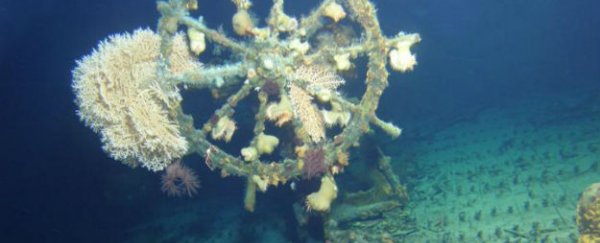A submersible drone has discovered a sunken World War II ship off the coast of the Hawaiian island of Oahu, more than half a kilometre below the surface.
After having transported telecommunications cables to and from the US, the ship was disposed of by torpedoing. But despite such a violent end, many parts of the ship, including its wheel and solitary mast, were found intact where they first fell. Even its navy ship number, IX-71, was perfectly preserved on its bow.
"The upper deck structures from the bow to the stern were well-preserved and showed no sign of torpedo damage," submersible pilot Terry Kerby from the University of Hawaii's Undersea Research Laboratory, said in a statement. "It is always a thrill when you are closing in on a large sonar target with the Pisces submersible, and you don't know what big piece of history is going to come looming out of the dark."
Originally named the Dickenson, the ship made its maiden voyage in 1923, joining the Commercial Pacific Cable Company fleet in transporting supplies for the burgeoning US submarine telecommunications network, and maintaining the cables laid around the Midway and Fanning Islands in the North Pacific Ocean. In July 1941, it arrived in Hawaii.
Five months later, after the bombing of Pearl Harbour on 7 December 1941, the Dickenson was given the new job of evacuating British telecommunications employees from Midway Island to Oahu, says Tia Ghose at LiveScience. "Some of the evacuees even spotted a submarine tailing their ship, before American ships chased it away," she reports.
With the war came the end of the Midway Island telecommunications network, and the Dickenson was given the new name - the U.S.S. Kailua. It was used to maintain other cable networks in the South Pacific, but once the war ended, no one wanted it. And what do you do when you want to throw away an entire ship after a global war? On 7 February 1946, the U.S.S. Kailua was sunk via torpedo off the coast of Oahu.
"From her inter-island service to her role in Pacific communications and then World War II," Hans Van Tilburg from the National Oceanic and Atmospheric Administration's Office of Marine Sanctuaries said in the press release, "Dickenson today is like a museum exhibit resting in the darkness, reminding us of these specific elements of Pacific history."
Sources: LiveScience, EurekAlert
